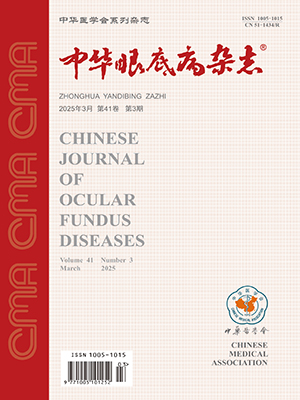Objective To investigate the effect of photodynamic therapy (PDT) combined with intravitreal bevacizumab on wet age-related macular degeneration (AMD). Methods In this retrospective study, 34 eyes (28 cases) diagnosed with wet AMD received PDT combined intravitreal injection of bevacizumab, including 25 eyes with classic CNV and 9 eyes with minimally classic CNV by fluorescein angiography; On optical coherence tomography (OCT), 23 eyes showed intraretinal fluid (IRF) and 11 eyes presented subretinal fluid (SRF). After signing informed consent, all patients underwent initial standard PDT followed by intravitreal bevacizumab (1.25 mg) within succeeding 3 to 7 days. Best corrected visual acuity (BCVA) and OCT with routine eye examinations were evaluated monthly. Additional bevacizumab (1.25 mg) was injected intravitreally if new or increasing fluid appreciated on OCT, or BCVA lowered more than 5 letters even with stabilized fluid. Injection was discontinued if no fluid was showed on OCT ( quot;dry macular quot;), or BCVA was stabilized even with fluid after two consecutive injections. BCVA and central retinal thickness (CRT) were analyzed and compared between baseline and 6 month follow-up. The correlation between parameters such as baseline BCVA, greatest linear dimension (GLD), type of CNV, SRF or IRF and posttreatment BCVA will be analyzed. The injection number of bevacizumab and complications were recorded. Results Compared to baseline, BCVA improved (9.4 plusmn;10.2) letters and reach 44.9 plusmn;21.3 letters (t=5.438,P<0.01) and CRT decreased (184.6 plusmn;214.6) mu;m (t=4.810,P<0.01) at 6 month visit. The average of injection number was 1.9 plusmn;0.9 (including initial injection of combination therapy). With multiple lineal regression analysis, only baseline BCVA correlated to posttreatment BCVA at 6 month visit (r=0.802.P<0.01). The type of CNV, GLD, SRF or IRF on OCT and CRT at baseline were not associated to post-treatment BCVA (r=0.053, -0.183, 0.139 and 0.053, respectively.P>0.05). BCVA of eyes with SRF (14.7 letters) increased more than eyes with IRF (6.9 letters) on OCT (t=-2.207,P=0.035). The change of BCVA after treatment (t=-0.076), change of CRT (t=-1.028) and number of injections (Z=-1.505) were not different between classic CNV and minimally classic CNV (P>0.05). The change of CRT (t=-0.020) and number of injections (Z=-0.237) did not present difference between SRF and IRF (P>0.05). The change of BCVA (t=1.159) and number of injections (Z=-1.194) were not correlated to whether residual fluid or not at 6 month visit (P>0.05). No severe complications were noticed during follow-up.Conclusion For wet AMD patients, PDT combined intravitreal bevacizumab could improve visual acuity, reduce retinal thickness and control CNV progress in a short-term.
Citation: 马臻,王海燕,王雨生,张鹏,胡丹,孙董洁,李曼红,李蓉. Effect of photodynamic therapy combined with intravitreal bevacizumab on wet age-related macular degeneration. Chinese Journal of Ocular Fundus Diseases, 2013, 29(4): 356-361. doi: Copy
Copyright © the editorial department of Chinese Journal of Ocular Fundus Diseases of West China Medical Publisher. All rights reserved




